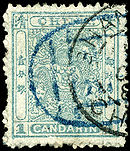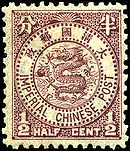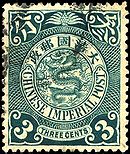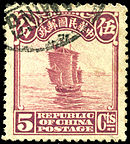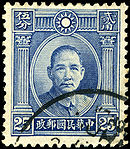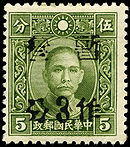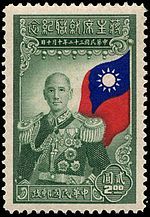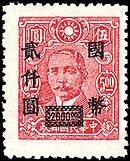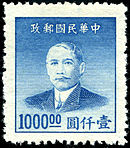- Postage stamps and postal history of China
-
The history of the postage stamps and postal history of China is complicated by the gradual decay of Imperial China and the years of civil war and Japanese occupation in the 1930s and 1940s.
Contents
Imperial China
Regular government postal service is known from the Zhou Dynasty in the 1st millennium BC. During the Yuan Dynasty under Kublai Khan in the 12th century, China was integrated into the much larger Mongolian Örtöö system. Marco Polo reported that there were 10,000 post stages during that time. In addition, private letters were carried by the Min Hsin Chu, a system of letter guilds (hongs). Later the 1727 Treaty of Kyakhta with Russia provided for the first regular exchange of mail.
A policy of isolation was forcibly ended in the 19th century by the Opium War and the subsequent opening of treaty ports; several nations opened foreign post offices from 1844 on. This expanded to involve dozens of cities, mostly on the coast, along the Yangtze River, and in the far south. Shanghai organized its own Shanghai local post in 1865. In the same year, the Englishman Robert Hart developed a mail service for the Imperial Maritime Customs, initially to carry consular mail to and from treaty ports. This service was opened to the public on 1 May 1878, and China's first postage stamps, the "Large Dragons" (大龍郵票), were issued to handle payment. The stamps were inscribed "CHINA" in both Latin and Chinese characters, and denominated in candareens.
Initially, all mail to foreign destinations went through Shanghai, but by 1882 there were twelve post offices. On 20 March 1896, an edict directed that the Customs Post become the Imperial Postal Service effective 1 January 1897; the Min Hsin Chu was shut down, as well as the Shanghai local post, and postal system adopted cents and dollars as the units of currency.
Through the first half of 1897, new stamps were unavailable, and so the existing stock was surcharged in cents, with several variants distinguished by philatelists. Revenue stamps were surcharged as well.
The first new stamps, inscribed "IMPERIAL CHINESE POST" went on sale 16 August 1897. The twelve values, ranging from 1/2c to $5, were lithographed in Japan. The low values depicted a dragon, the middle values a carp, and the dollar values a wild goose. This paper used for these stamps had a watermark in the form of a yin-yang symbol.
In 1898, these were superseded by similar designs produced by engraving in London, and inscribed "CHINESE IMPERIAL POST" on a Chinese supplied watermarked paper of varying thickness. The watermark can be difficult to detect on the thicker paper. New printings of the stamp, beginning in 1899 were on unwatermarked paper, but there are no recorded usages of this variety until 1901. These stamps continued in use until the end of the empire. During that time some colours were changed to comply with Universal Postal Union regulations, and three new values were added.[1]
The first commemorative stamps of China were issued in 1909 to mark the 1st year of the reign of the Xuantong Emperor. The set of three (2c, 3c, 7c), all depicted the Temple of Heaven in Beijing.
Revolution and republic
The 1910s
 This revolutionary overprint was made in London on a 30c imperial stamp. The postmark may read "HANGCHOW".
This revolutionary overprint was made in London on a 30c imperial stamp. The postmark may read "HANGCHOW".
The revolution of 1911 resulted in overprints on the imperial stamps in 1912; at Foochow to indicate that the post office was effectively a neutral area available to both sides, and at Nanking and Shanghai reading "Republic of China". An additional set of overprints were produced by Waterlow and Sons in London, and postmasters throughout the country made their own unofficial overprints using the same characters.
The first new designs of the Republic were two commemorative sets of 12 each, the first set depicting Sun Yat-sen and second Yuan Shikai, both issued on 14 December 1912.
The definitives of the "Junk issue" went on sale 5 May 1913, and continued in use into the 1930s. The low values featured a junk, while values from 15c to 50c showed a farmer reaping rice, while the dollar values depicted the three-part gateway to the Hall of Classics in Beijing. The series was first printed in London, then in Beijing from 1915; they can be distinguished by close examination. The designs were re-engraved in 1923, and a number of design features were changed; for instance, the whitecaps in the water underneath the junk were removed, and the water darkened.
The 1920s
China produced five new commemorative issues, of four stamps each, during the 1920s. The first, issued on 1921-10-10 to commemorate the 25th anniversary of the Chinese Post Office featured then president Xu Shichang in the centre, flanked by Premier Jing Yongbeng and Minister of Communication Ye Gongzuo. On 1923-10-17 a set showing the Temple of Heaven commemorated the new constitution. On 1928-03-01 a set depicting Marshal of the Army and Navy Zhang Zuolin marked his assumption of that role. On 1929-04-18 Chiang Kai-shek makes a first appearance, commemorating the unification of China. Finally on 1929-05-30, two days before the event, four stamps showing Sun Yat Sen's mausoleum were issued to commemorate his state funeral.[2]
The 1930s
New definitives in 1931 depicted Sun Yat-sen. These stamps, along with the Martyrs issue of 1932 honoring six martyrs of the Kuomintang, would see much overprinting in the next several years. 1931 also saw the invasion of Manchuria by the Japanese and the formation of Manchukuo, which issued its own stamps. Communist authorities issued stamps in areas over which they had control from 1930 onwards. These were usually in more remote areas, often on the mountainous borders of two provinces - hence they are often referred to as 'Border Areas'. For example, the earliest communist issues (the so called 'Red Posts') were in mountainous areas of Jiangxi, the Hunan - Hubei border area and West Fujian, bordering Jiangxi.
Wartime
Japanese occupation
Postwar
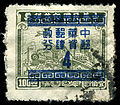 This silver yuan overprint on a revenue stamp was used for only a few months in mid-1949.
This silver yuan overprint on a revenue stamp was used for only a few months in mid-1949.
The end of the conflict brought little respite to the Nationalist government, which continued to struggle with Communist forces. But they were able to issue commemoratives to remember President Lin Sen, who had died in 1943, to mark the October inauguration of Chiang, and to celebrate the Allied victory.
Inflation had been creating a need for ever-higher values throughout 1945, but in 1946 things went out of control; stocks of stamps, some dating back to 1931, were surcharged with values up to $2000, and a new design (still featuring a portrait of Sun Yat-sen) went up to $5000.
1947 saw a number of commemorative issues, and further inflation, a Sun Yat-sen with plum blossoms issue reaching $50,000 that year, then surpassed in 1948 with reissues topping out with a $5,000,000 stamp.
In 1948, a gold yuan standard was adopted, and an assortment of existing stamps were surcharged with values from 1/2c and up. This was a short-lived stopgap, and by early 1949 it became necessary to stamps and overprints with a range of values, again going up to $5,000,000.
On 1 May 1949, the government took a desperate step, which was to print undenominated stamps, sold at the daily rate of the yuan. They then adopted a silver yuan standard, and overprinted still more stamps as well as reissuing the Sun Yat-sen design valued in 1-500 cents. By August, the deteriorating political situation had caught up with the postal system, and the Nationalists' last issues on the mainland were two of a planned series of pictorial designs denominated in silver yuan.
Division
Philatelists conventionally split into two separate topics at this point:
- Postage stamps and postal history of the Republic of China (first stamps 1912)
- Postage stamps and postal history of the People's Republic of China (first stamps 8 October 1949)
See also
- China Philatelic Society of London
- China Stamp Society
- Chinese Golden Monkey stamp
- Chinese Postal Map Romanization
- Postage stamps and postal history of the People's Republic of China
- Postage stamps and postal history of Hong Kong
- Postage stamps and postal history of Macau
- Sun Yat-sen stamps
References
Notes
Sources
- Stanley Gibbons Ltd: various catalogues
- Encyclopaedia of Postal History
- Stuart Rossiter & John Flower: The Stamp Atlas
Postage stamps and postal history of Asia Abu Dhabi · Aden · Afghanistan · Alaouites · Alexandretta · Annam-Tongking · Armenia · Azerbaijan · Bahawalpur · Bahrain · Bangladesh · Bangkok · Bhutan · Brunei · Burma · Cambodia · Ceylon · China · China P.R.C. · East Timor · Far Eastern Republic · Hatay · Hong Kong · India · Indian States · Indochina · Indonesia · Iran · Iraq · Israel · Japan · Japanese P.O. in Korea · Jordan · Kazakhstan · Korea · Kuwait · Kyrgyzstan · Laos · Lebanon · Macau · Malaysia · Maldives · Mongolia · Muscat and Oman · Nepal · Netherlands East Indies · North Korea · Pakistan · Palestine · Palestinian National Authority · Philippines · Portuguese India · Qatar · Russia · Ryukyu Islands · Saudi Arabia · Shanghai and China Treaty Ports · Sharjah · Singapore · South Korea · Sri Lanka · Straits Settlements · Syria · Taiwan · Tajikistan · Thailand · Tibet · Turkey · Turkmenistan · Tannu Tuva · U.A.E. · Uzbekistan · Vietnam · Western New Guinea · YemenSee also: Africa · Americas · Europe · Oceania · Portal · WikiProject Categories:- Postal system of China
- Postage stamps by country
- Postal history by country
Wikimedia Foundation. 2010.


